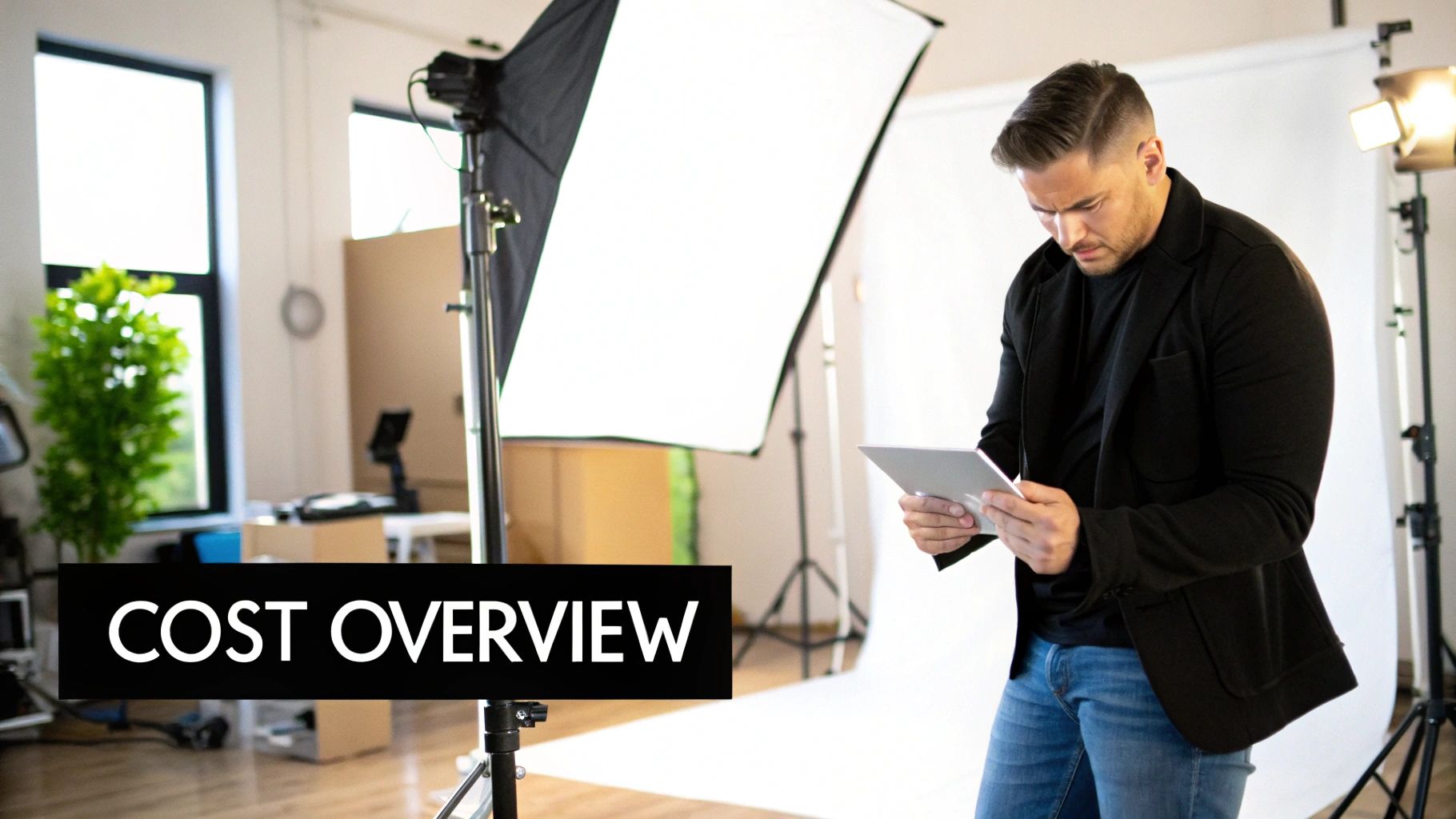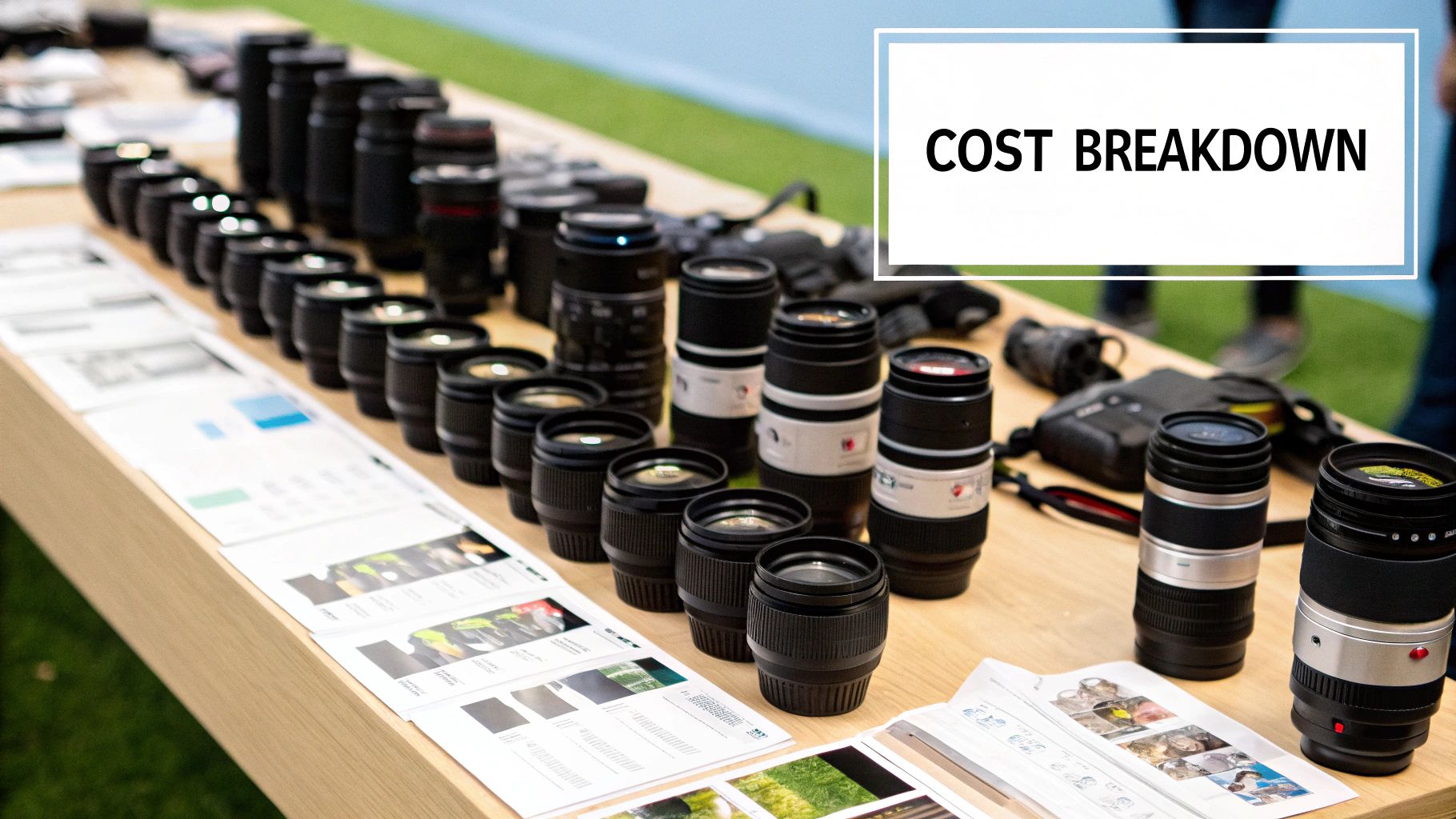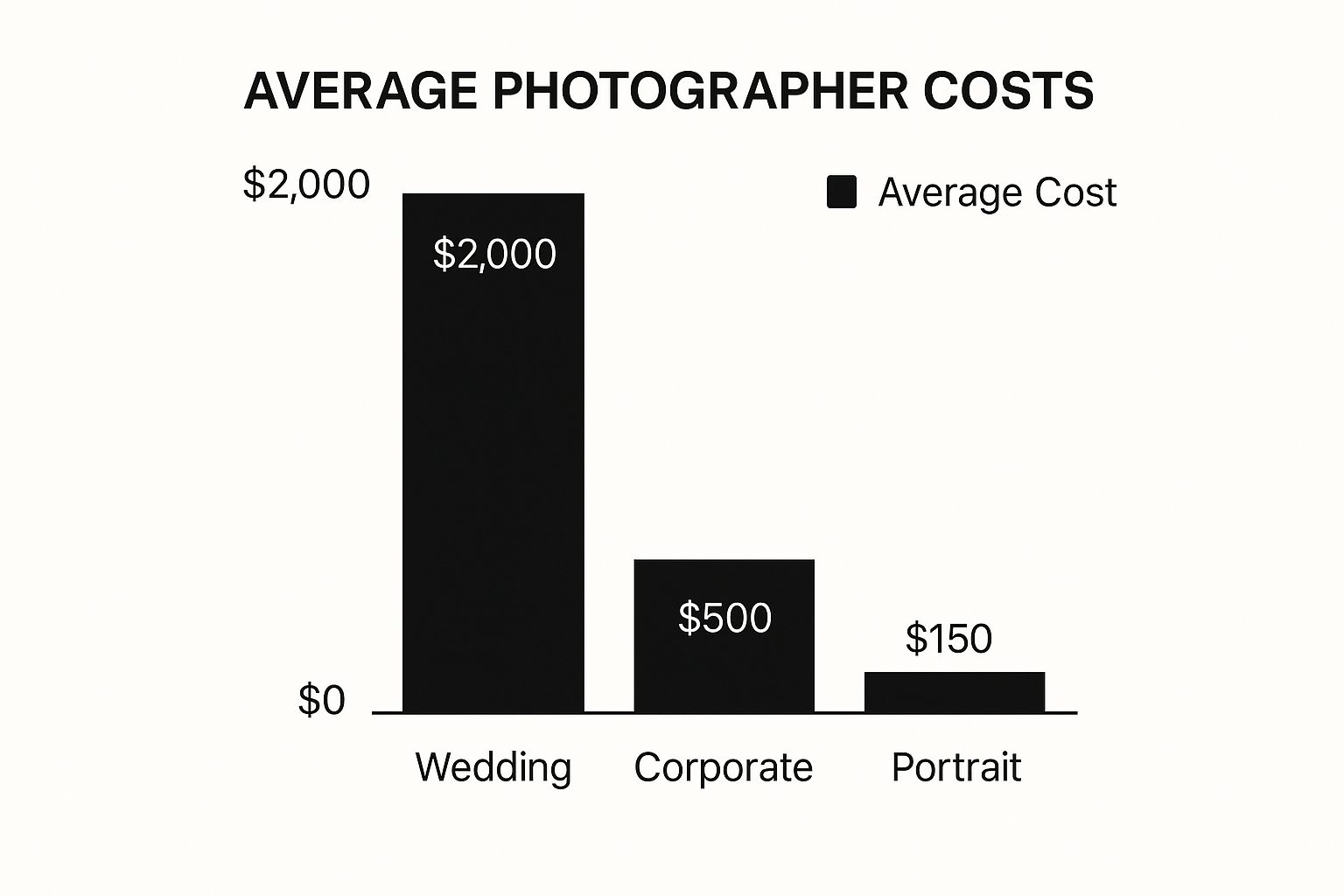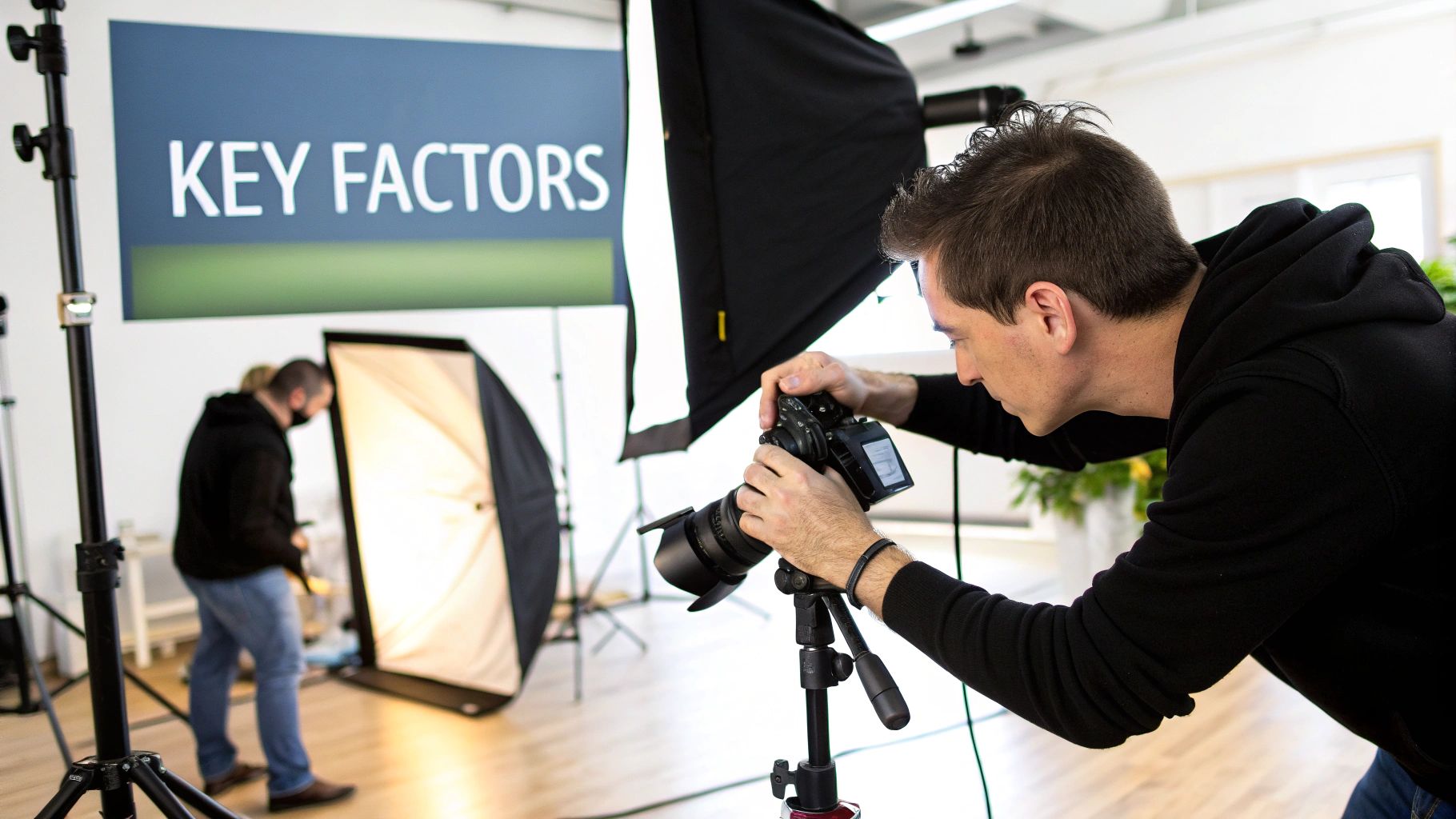So, how much does a photographer actually cost? It’s a bit like asking for the price of a car—you can’t really get a straight answer without knowing the make, model, and what features you want. The short answer is that rates can swing from $150-$280 per hour for events to $1,800-$6,500 per day for something as involved as a wedding. Portrait sessions usually fall somewhere in the $440-$550 range.
But those numbers are just a starting point. The final price tag depends on what you need, the photographer's experience level, and even where you live.
Deconstructing the Average Photographer Cost

Think about it: a simple headshot session is a world away from capturing a full-day wedding. The time, skill, and gear required for each are completely different, and the pricing reflects that. A headshot might take an hour, while a wedding photographer is on their feet for 8-10 hours, followed by dozens of hours of editing.
Rates vary wildly across different specialties. Event photography often hovers between $150 to $280 an hour, while a classic portrait session typically averages $440 to $550. Weddings are a much bigger investment, with packages starting around $1,800 and easily climbing to $6,500 or more for a top-tier pro.
Location is another huge factor. In a major city like Sydney, a corporate event photographer might charge AUD 180-280 per hour, but highly specialized architectural work in the same city could command up to AUD 3,300 for a single project. The market you're in really matters.
Average Photographer Costs at a Glance
To give you a clearer picture, here’s a quick breakdown of what you can generally expect to pay for different kinds of photography. These are ballpark figures, of course, and every photographer will have their own unique pricing.
| Photography Service | Average Cost (Per Hour) | Average Cost (Per Session/Event) |
|---|---|---|
| Wedding Photography | $200 – $600+ | $1,800 – $6,500+ |
| Portrait Session | N/A | $440 – $550 |
| Event Photography | $150 – $280 | $600 – $2,240 (for 4-8 hours) |
This table gives you a solid baseline to start from. If you want to get more granular and figure out a custom estimate, using a freelance rate calculator can help you dial in the numbers for your specific project.
What About the Extras?
It’s also important to remember the add-ons that can pop up. Things like extra shooting hours, a second photographer, prints, or special editing requests will all affect the final price.
For events, you might be thinking about fun extras. For example, understanding the true cost of photo booths can help you budget for that kind of add-on. These services add a ton of value, but they’ll also bump up your total investment.
How Photography Specialization Shapes Pricing

Not all photography is created equal, and the niche a photographer works in has a massive impact on their rates. Think of it like hiring a contractor: a general handyman and a master electrician who wires commercial buildings have wildly different skill sets and price tags. Each type of photography requires a unique approach, level of expertise, and specialized gear.
This is exactly why a wedding photographer's invoice looks nothing like one from a product photographer. One is capturing the beautiful chaos of a live, unrepeatable event, while the other spends hours in a studio perfecting the light on a single object. Getting a handle on these differences is the key to setting a realistic budget for what you need.
Wedding Photography: The High-Stakes Specialization
Wedding photography is consistently one of the most expensive specializations, and for good reason. It's a high-pressure, one-shot deal that blends portraiture, event coverage, and documentary storytelling into one marathon day. There are no do-overs if the photographer misses the "I do" kiss or a candid, tearful moment between family members.
This environment demands a photographer with exceptional people skills, technical mastery under pressure, and the stamina for a 10-12 hour day. And once the cake is cut, their work is far from over. They're looking at another 20-40 hours of culling thousands of images and meticulously editing the final collection. That intense labor, combined with immense responsibility, is what drives the premium cost.
In the United States, the average wedding photographer's fee hovers around $2,900. When you break it down, that can work out to an effective hourly rate of $363 for a full-day package. This isn't just about paying for their time on-site; it reflects the mountain of post-production work and the sheer demand for comprehensive, high-quality coverage.
Portrait and Headshot Photography
Portrait and headshot sessions are typically far more controlled and shorter than weddings, which you'll see reflected in their pricing. A family portrait session might be an hour or two at a park, while a corporate headshot shoot could involve setting up a mobile studio right in an office.
The real value here comes from the photographer's ability to direct people, create a comfortable atmosphere, and master lighting to capture flattering, professional images. The editing is less intensive than a wedding, but it still requires expert retouching to make sure everyone looks their absolute best.
These photographers often charge per session or by the hour, usually with packages that include a set number of edited digital images.
- Basic Headshot Package: Usually a 30-minute session that delivers 1-3 retouched digital photos.
- Family Portrait Package: A 1-2 hour session at a location of your choice, resulting in a gallery of 20-50 edited images.
- Corporate Team Package: Involves shooting multiple employees back-to-back, with pricing often structured per person to make it more cost-effective for the business.
Commercial and Product Photography
This is where the pricing model often shifts completely. Instead of charging by the hour, commercial photographers frequently work on a per-image or project-based fee. This specialization is all about creating images specifically for marketing and sales, whether for an e-commerce site, an ad campaign, or a restaurant menu.
The core idea behind commercial photography is value-based pricing. The cost isn't just tied to the photographer's time and effort; it's linked to the commercial value the images will generate for the client's business.
A single, perfectly executed product shot can take hours to light, style, and capture. The post-production is just as painstaking, often involving complex techniques like focus stacking and color correction to make the product look absolutely irresistible. The photographer isn't just selling a picture; they're selling a tool that directly helps a business make money.
A photographer's portfolio is the ultimate proof of their skill in any niche. To see how the pros showcase their specialized work, check out these outstanding creative portfolio examples that show mastery across different fields.
Real Estate and Architectural Photography
Real estate photography is another highly specialized field with its own pricing rules. The goal is simple: make a property look so appealing that it gets potential buyers through the door. This requires specific gear like wide-angle lenses, a deep understanding of light, and techniques like HDR (High Dynamic Range) blending to capture every last detail.
Pricing is usually based on the square footage of the home or a flat rate for a certain number of images.
- A standard shoot for a mid-sized home might run you between $230 and $320.
- Add-ons like drone photography for aerial shots can add another $50 to $250.
- Virtual tours are becoming a must-have, and can range from $100 to $800 or more depending on the tech involved.
Ultimately, each specialization demands a distinct set of skills, equipment, and workflows. Once you understand what goes into each type of shoot, you can better appreciate the costs involved and find the right pro whose expertise lines up perfectly with your goals.
Ever wonder why a photographer in a major city can charge five times what a talented student in a small town does? It boils down to two huge factors that shape what you'll pay: their experience and their location.
Getting a handle on this is key to setting a realistic budget. You're not just paying for pictures; you're investing in a certain level of skill, reliability, and artistic eye—all of which are tied to a photographer's career stage and the local market they work in.
This chart gives you a quick visual on how baseline costs can shift dramatically just based on the type of photography you're looking for.

As you can see, weddings are a completely different ballpark compared to something like a corporate headshot session.
From Novice to Expert: The Experience Factor
Think of a photographer’s experience like a chef's. A new line cook can follow a recipe, but a seasoned chef brings years of refined technique, creativity, and consistency to the table. You pay a premium for that mastery, and it's the exact same in photography. More experience almost always means a more polished final product and a smoother, more professional process for you.
Here’s a rough breakdown of the tiers you’ll encounter:
- Amateur/Student: These photographers are just starting to build their portfolios. They might have a great eye but often lack the pro-level gear and battle-tested workflow. Their rates are the lowest, making them a great choice for casual shoots where the stakes aren't too high.
- Semi-Pro: With a few years of shooting under their belt, semi-pros have developed a consistent style and a solid body of work. They might do photography part-time. Their pricing hits a sweet spot, offering a fantastic balance of quality and affordability for things like family portraits or smaller events.
- Professional: This is their full-time job. A pro has an established business, top-of-the-line equipment, and a deep understanding of lighting, composition, and editing. They deliver high-quality, consistent results and know how to handle curveballs. Their rates reflect their dedication and expertise.
- Top-Tier/Luxury: These are the industry leaders, known for a signature artistic style and an exclusive client list. They’re often shooting high-end weddings, national ad campaigns, or fine art. Their prices are the highest, reflecting their premium brand, exceptional skill, and the one-of-a-kind experience they offer. When you hire a freelancer at this level, clear communication is everything; our guide on how to work with freelancers can help you nail that partnership.
A photographer with a decade of experience isn't just selling photos. They're selling peace of mind—the confidence that they can deliver stunning images no matter the weather, lighting, or unexpected hiccups.
City Prices vs. Rural Rates: The Location Factor
Just like a cup of coffee costs more in New York City than in rural Nebraska, photographer rates are heavily tied to geography. It all comes down to the local cost of living and market demand. A photographer in a major city has higher business expenses—from studio rent to insurance—and those costs naturally get factored into their pricing.
Plus, big cities have bigger, more competitive markets with a higher demand for premium services, allowing top pros to charge more. While the national average for a photo session hovers around $200, that number can be really misleading without context.
Hourly rates typically fall between $100 and $250, but the regional differences are stark. A photographer in California might quote $250 to $500 for a session, while someone in New York could be charging $300 to $600.
Regional Photography Cost Comparison (Per Session)
This table gives you a clearer picture of how much a standard portrait session can vary just by crossing state lines.
| State/Region | Average Portrait Session Cost Range |
|---|---|
| New York | $300 – $600 |
| California | $250 – $500 |
| Texas | $200 – $400 |
| Florida | $150 – $350 |
At the end of the day, these two factors—experience and location—are deeply intertwined. The most sought-after photographers often gravitate toward major cities where they can serve a larger client base and charge rates that truly reflect their expertise. When you get a quote, you're seeing a price shaped by both years of practice and the zip code they call home.
Decoding Photography Quotes and Add-Ons

The first number a photographer throws at you is rarely the final number. It’s just the base of the pyramid. To really get a handle on what you'll be paying, you have to look past that initial quote and understand the common add-ons and extra fees that will shape your final bill.
These aren't "hidden" charges. Think of them as optional services and logistical costs that let you customize the shoot to get exactly what you need. It’s like ordering a pizza—the plain cheese is your starting point, but you pay for every topping you add. A photography package works the same way.
Common Line Items and Service Add-Ons
When you get a quote, you'll see a list of services. Some are standard, others are upgrades. Knowing what's what helps you see where your money is going and decide what’s actually important for your project.
Here are a few of the most frequent add-ons you'll run into:
- Second Photographer: For big events like weddings, a second shooter is a game-changer. They capture different angles, candid moments, and all the things one person just can't. This typically adds $300 to $1,000 to the package, based on their experience and how long they're needed.
- Travel Fees: If your shoot is outside the photographer's usual service area (often a 30-50 mile radius), expect a travel fee. This covers their time, gas, and maybe even a hotel for destination events.
- Studio or Location Rental: While lots of shoots happen out in the world, sometimes you need the controlled environment of a studio. Rental fees can run from $50 an hour for a basic space to several hundred for a high-end commercial studio with all the bells and whistles.
- Additional Hours: Most packages lock in a set number of hours. If your event goes long or you just need more time, you’ll pay for overtime. This usually runs between $150 to $400 per hour.
Getting a clear picture of these potential costs upfront saves you from any budget-busting surprises later on. Always ask for a full list of services and their fees before you sign on the dotted line.
The World of Post-Production and Deliverables
The magic doesn't end when the shutter clicks. Post-production is where your raw images are transformed into polished, professional photos. It’s a ton of work, and more advanced editing comes with a higher price tag.
Post-production is where a photographer’s artistic style truly shines. It’s not just about removing blemishes; it's about color grading, composition, and storytelling that brings the entire collection of images to life.
Here’s what can bump up the cost after the shoot is over:
- Advanced Retouching: Basic edits like color correction and exposure adjustments are almost always included. But if you need detailed work—like removing objects from a background, heavy skin smoothing, or combining multiple images—that’s a specialized skill and is usually billed per image.
- Custom Albums and Prints: A professionally designed photo album is a beautiful way to hold onto memories. Costs vary wildly depending on size, page count, and material quality, starting around $500 and going well over $2,000.
- Rush Delivery: Need your photos yesterday? Most photographers offer an expedited editing service for an extra fee, getting your images back to you way faster than the standard turnaround time.
Understanding Image Licensing and Usage Rights
Finally, let's talk about one of the most critical parts of any photography agreement: image licensing. This is the part of the contract that spells out exactly how you're legally allowed to use the photos. It's not about owning the copyright—the photographer almost always keeps that—it’s about the rights you’re buying.
For personal use, like family portraits, you’ll typically get the rights to print and share the photos online. But for commercial projects, where the images are used to make money (think ads or product packaging), the licensing fees will be much higher because the photos have a direct business value.
Getting this wrong can lead to serious legal headaches. A rock-solid contract is your best friend here. You can get a better sense of what to look for with a good freelancer contract template that breaks down all these key areas.
Budgeting for a Photographer Without Compromise
Getting amazing photos doesn't mean you have to empty your wallet. Smart budgeting isn't about a race to the bottom to find the cheapest person with a camera; it's about getting the absolute best value for what you're investing. If you think strategically, you can land a talented pro who gets your bottom line without skimping on the quality you're after.
The trick is to look past the sticker price and get laser-focused on what you actually need. Are you about to pay for an all-day wedding package when you really just need someone for the ceremony and the first couple hours of the reception? The first step to a budget-friendly solution is simply aligning the photographer's services with your real priorities.
Pinpoint Your Priorities and Be Flexible
Before you even start scrolling through gorgeous portfolios, figure out your non-negotiables. What are the "must-have" shots? Is it the candid, unposed moments with your family? Flawless corporate headshots for the team? Or maybe it's those epic, dramatic photos of your wedding venue at sunset. Knowing what truly matters helps you trim the fat from any potential package.
When you can clearly communicate these priorities to a photographer, you open the door for them to create a custom package that fits both your vision and your budget. You’d be surprised how flexible most photographers can be when you’re upfront with them.
Here are a few practical ideas to kick around:
- Book During the Off-Season: Wedding photographers, for instance, are slammed from spring through fall. If you’re planning a winter wedding, you could see a 10-20% discount just because of lower demand.
- Opt for Shorter Coverage: Instead of a full eight-hour package, ask if they offer a four or six-hour option. This is a perfect way to capture the most important parts of your event without paying for all the in-between downtime.
- Bundle Your Services: Need engagement photos and wedding day coverage? Ask if they offer a bundled rate. A lot of photographers will cut you a deal for booking multiple sessions at once.
Have a Transparent Conversation About Your Budget
I get it, talking about money can feel a little awkward. But when it comes to hiring a creative, transparency is your best friend. An open, honest chat with a potential photographer builds immediate trust and can lead to some really creative solutions you might not have thought of. Just start by explaining your vision, and then share your budget range.
A true professional understands that every client has financial lines they can't cross. A good one will partner with you to find a solution, not just hand you a take-it-or-leave-it price tag.
When you're looking over quotes, sometimes it helps to see how other professional fields break down their costs. For instance, understanding the pricing of professional services in totally different industries can give you some useful context for making sense of various pricing models and add-on fees.
Having a clear budget from the start also makes managing your overall project finances way less stressful. If you want to take a deeper dive into financial planning for creative projects, our guide on marketing budget planning has some great frameworks. By just being clear and respectful, you'll find a photographer who not only delivers incredible images but also offers a service that fits comfortably within your financial plans. It’s a proactive way to make sure you're investing wisely in memories that will last a lifetime.
Your Questions About Photographer Costs, Answered
Let's get into the questions everyone has but might feel a little awkward asking. This is where we give you straight, clear answers about photography pricing so you can make sense of the quotes you’re seeing.
We’ll break down why pro photography can feel like a big investment, what to expect in your final photo gallery, and even the etiquette around tipping. Think of this as your cheat sheet for budgeting with confidence.
Why Is Professional Photography So Expensive?
It’s a totally fair question. When you get a quote for a few hundred or even several thousand dollars, it’s easy to wonder if you’re just paying for someone to click a button for a couple of hours. But the photoshoot itself is just the tip of the iceberg.
Hiring a photographer is a lot like hiring a master carpenter to build custom cabinets. You're not just paying for the wood and the time they spend in your house. You're paying for their years of honed skill, their expensive tools, the design and planning phase, and the overhead of their workshop.
A photographer's price tag covers a whole lot more than just their time on-site.
- Serious Gear: A pro camera body alone can run $3,000-$6,000, and each high-quality lens adds another $1,500-$2,500. Then there’s lighting gear, memory cards, powerful computers, and pricey software—all of which need constant maintenance and upgrades.
- Hours of Editing: For every single hour of shooting, a photographer easily spends another 2-3 hours in post-production. This is the unseen work: sorting through hundreds (or thousands) of images, color correcting, retouching, and polishing the final gallery.
- The Cost of Doing Business: Just like any other small business, photographers have major operating costs. We're talking insurance, marketing, website hosting, accounting software, client management systems, and sometimes, studio rent.
- Expertise and Vision: You’re also paying for their skill. This comes from years of practice, continuous education through workshops, and the artistic eye to create stunning, consistent work, even when the pressure is on.
When you start adding up all these behind-the-scenes costs, that average photographer cost starts to make a lot more sense. You’re not just hiring a person with a camera; you're investing in a skilled professional who runs a legitimate business.
How Many Photos Will I Receive?
This is a big one, and the answer really depends on the type of shoot and the photographer's package. It’s always a classic case of quality over quantity. A great photographer’s goal isn’t to overwhelm you with thousands of unedited files; it’s to deliver a curated collection of beautifully finished images that tell a complete story.
For instance, a one-hour family portrait session might get you a gallery of 25-50 perfectly edited images. An eight-hour wedding? You could expect anywhere from 400 to 800 edited photos. A corporate headshot session, however, might only deliver 1-3 flawless retouched images per person.
Always, always clarify the number of delivered photos before you sign a contract. A good photographer will spell this out clearly in their package details so there are no surprises later on.
It’s also good to know the difference between a "proof gallery" and the final delivery. Some photographers might share a larger album of lightly edited proofs for you to pick your favorites, which they’ll then fully retouch for the final handoff.
Do I Need to Tip My Photographer?
Tipping in the photography world can feel a little fuzzy. Unlike a server in a restaurant, photographers set their own rates to cover all their costs and earn a living. Because of that, a tip is never expected, but it is always deeply appreciated.
Think of it as a bonus for amazing service. If your photographer went above and beyond—staying late, masterfully handling a tricky situation, or delivering your photos way ahead of schedule—a tip is a fantastic way to show your gratitude.
So, if you decide you want to tip, what’s the standard?
- For a primary photographer (like at a wedding): A tip of $100-$200 is a common and very generous gesture.
- For a second shooter or assistant: Handing them $50-$100 is a really thoughtful way to say thanks.
- For a portrait session: If you loved the experience, 10-20% of the session fee is a great guideline.
If a cash tip isn't in the budget, no sweat. There are other ways to show your appreciation that are just as valuable to a small business owner. Writing a glowing online review, referring them to your friends, or tagging them with enthusiasm on social media helps their business grow, and that’s worth its weight in gold.
Finding the right creative is about more than a price tag; it's about finding the right partner to bring your vision to life. At Creativize, we connect businesses with incredible local freelancers who have the skill and passion for the job. Explore our platform to discover photographers, designers, and animators right in your community. Find your next creative partner at Creativize.net.

